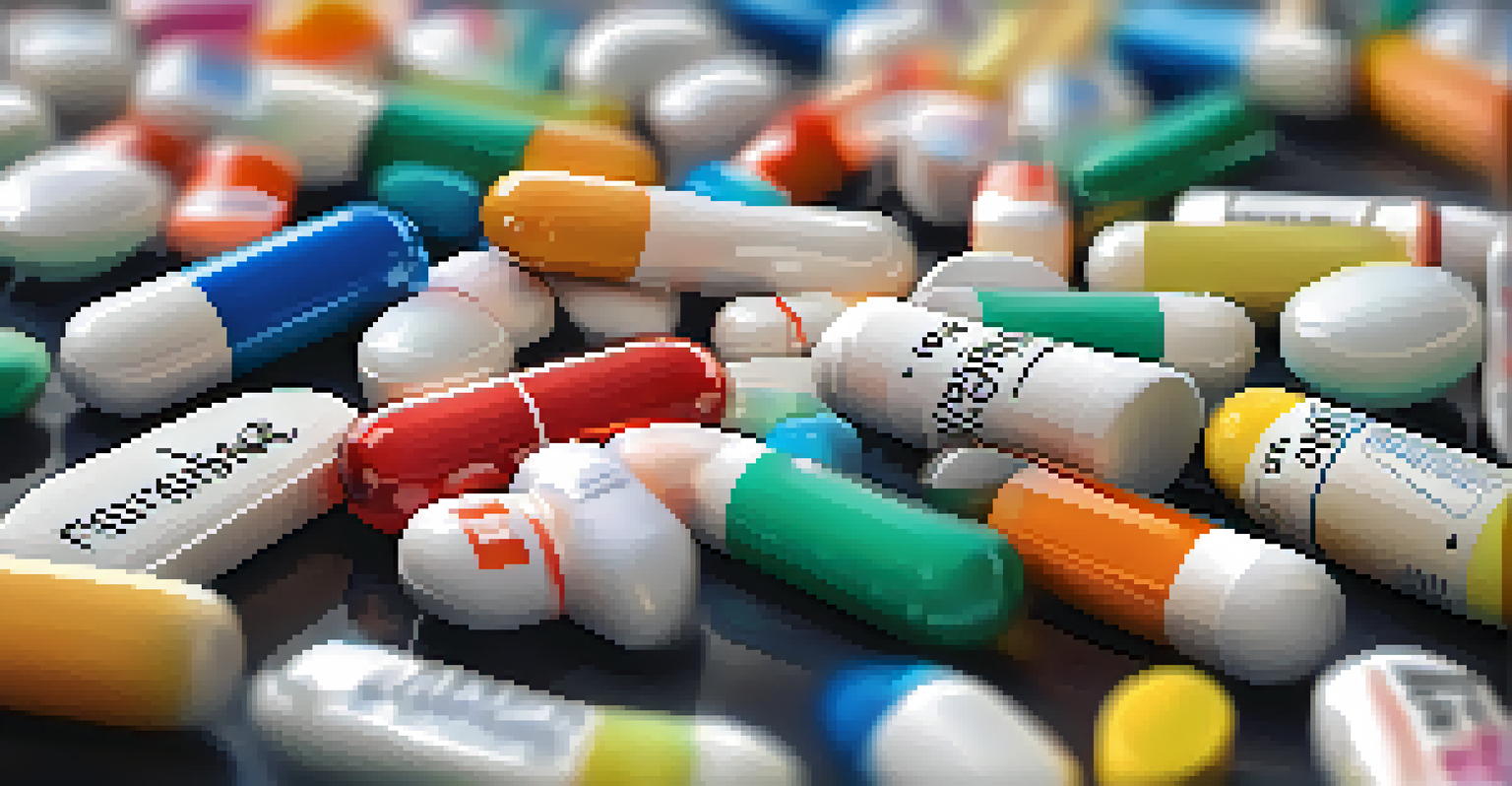Drug Repositioning: Finding New Uses for Existing Medications

Understanding Drug Repositioning and Its Importance
Drug repositioning, or repurposing, involves finding new therapeutic uses for existing medications. This approach can save significant time and resources in drug development, as the safety profiles of these drugs are already established. By investigating existing compounds, researchers can potentially discover new treatments for various diseases, making it a vital area of modern medicine.
Innovation is the ability to see change as an opportunity – not a threat.
One of the key advantages of drug repositioning is its ability to expedite the drug discovery process. Traditional drug development can take over a decade and cost billions, while repositioned drugs can often enter clinical trials much faster. This efficiency is especially critical in urgent situations, such as pandemics or emerging health crises.
Additionally, drug repositioning can lead to breakthroughs in treating conditions that currently have limited options. For instance, medications originally designed for arthritis have shown promise in treating certain types of cancers. This not only broadens the therapeutic landscape but also provides hope for patients who may not respond to conventional therapies.
Examples of Successful Drug Repositioning
One of the most famous examples of drug repositioning is the use of sildenafil, originally developed for angina, which is now widely known as Viagra for treating erectile dysfunction. This unexpected success story demonstrates how a drug's initial purpose can evolve significantly through research. It highlights the potential hidden within existing medications that can offer new solutions to different health issues.

Another noteworthy case is that of thalidomide, which was initially marketed as a sedative and later linked to severe birth defects. However, researchers discovered its effectiveness in treating multiple myeloma and certain skin conditions associated with leprosy. This example underscores the dual-edged nature of drug repositioning, where what was once deemed dangerous can be transformed into a lifesaving treatment under the right conditions.
Drug Repositioning Saves Time
Repositioning existing medications can significantly expedite the drug discovery process, providing quicker access to new treatments.
Moreover, the antimalarial drug chloroquine has been explored for its potential use against COVID-19, illustrating how urgent public health needs can drive the evaluation of existing medications. While results can vary, these attempts show the innovative spirit in the medical community and the ongoing quest to maximize existing resources.
The Role of Technology in Drug Repositioning
Advancements in technology have significantly enhanced the process of drug repositioning. Data analytics and artificial intelligence (AI) now play crucial roles in sifting through vast amounts of medical research and clinical data. These technologies can identify potential new uses for drugs by revealing patterns and connections that might not be immediately apparent to researchers.
The greatest discovery of my generation is that a human being can alter his life by altering his attitude.
For example, machine learning algorithms can analyze historical data on drug interactions and patient outcomes to suggest possible new applications for existing medications. This computational approach not only speeds up the discovery process but also increases the likelihood of identifying viable treatment options that might have been overlooked.
Additionally, platforms that facilitate collaboration among researchers, pharmaceutical companies, and healthcare providers are becoming essential. By sharing knowledge and data, these networks can help accelerate the repositioning of drugs, ultimately benefiting patient care and treatment availability.
Challenges of Drug Repositioning
Despite its promise, drug repositioning is not without challenges. One major hurdle is the need for substantial clinical testing to prove the efficacy and safety of a drug for its new use. Even though existing medications have a known safety profile, they may still have different effects in new patient populations or conditions.
Moreover, regulatory pathways can be complicated. The approval process for a new indication can vary significantly depending on the drug's original use and the disease it’s being repositioned to treat. Navigating these regulatory challenges requires careful planning and often lengthy negotiations with health authorities.
Technology Enhances Repositioning
Advancements in data analytics and AI are revolutionizing drug repositioning by identifying new uses for existing drugs more efficiently.
Finally, there’s the issue of intellectual property rights. Pharmaceutical companies may be hesitant to invest in repositioning a drug if they believe they won't recoup their investment due to existing patents. This economic consideration can slow down the process, despite the potential benefits for public health.
The Economic Benefits of Drug Repositioning
From an economic standpoint, drug repositioning can be a financially savvy strategy for pharmaceutical companies. Developing new drugs is not only time-consuming but also incredibly expensive. By leveraging existing medications, companies can potentially reduce development costs and timeframes while increasing the chances of a successful outcome.
This cost-effectiveness extends beyond the pharmaceutical companies to healthcare systems and patients. Fast-tracking effective treatments can lower healthcare costs associated with prolonged illness and hospitalizations. Ultimately, when patients have access to effective therapies sooner, the overall burden on the healthcare system diminishes.
Additionally, successful repositioning can lead to increased revenue streams for pharmaceutical companies. When a drug finds a new use, it can tap into entirely different markets and patient populations, broadening its commercial viability. This financial incentive helps to sustain ongoing research and development efforts in the industry.
Future Directions in Drug Repositioning Research
Looking ahead, the future of drug repositioning appears promising, particularly with ongoing advancements in genomics and personalized medicine. By understanding individual genetic profiles, researchers can tailor repositioned therapies to target specific patient needs more effectively. This personalized approach could significantly enhance treatment outcomes and minimize side effects.
Additionally, there is a growing emphasis on interdisciplinary collaboration in drug repositioning efforts. By bringing together experts from various fields—such as pharmacology, data science, and clinical practice—researchers can create more comprehensive strategies for identifying and validating new uses for drugs. This collaborative spirit is vital for overcoming the challenges that lie ahead.
Economic Benefits for Healthcare
Drug repositioning offers a cost-effective strategy for pharmaceutical companies, which can lower development costs and improve patient access to effective therapies.
Finally, as public health needs continue to evolve, drug repositioning will remain a critical area of focus. The COVID-19 pandemic has highlighted the importance of rapidly adapting existing therapies to meet emerging challenges. As we move forward, the ability to pivot and repurpose drugs will be essential for addressing future health crises.
Conclusion: The Promise of Drug Repositioning
In summary, drug repositioning represents an innovative approach to expanding the therapeutic uses of existing medications. With its potential to save time, reduce costs, and provide new treatment options, it is an exciting area of research within the pharmaceutical industry. The successful examples of repositioned drugs illustrate the incredible possibilities that lie in unlocking new uses for old medications.
As technology continues to advance and collaboration among researchers increases, we can expect to see even more breakthroughs in this field. The intersection of data analytics, AI, and interdisciplinary teamwork will pave the way for identifying new therapeutic opportunities. This dynamic landscape offers hope for patients and healthcare providers alike.

Ultimately, drug repositioning not only enhances our understanding of existing drugs but also reinforces the idea that innovation can emerge from the most unexpected places. By continuing to explore and invest in this area, we can look forward to a future where more effective treatments are readily available, improving health outcomes for countless individuals.